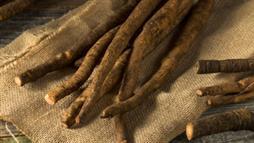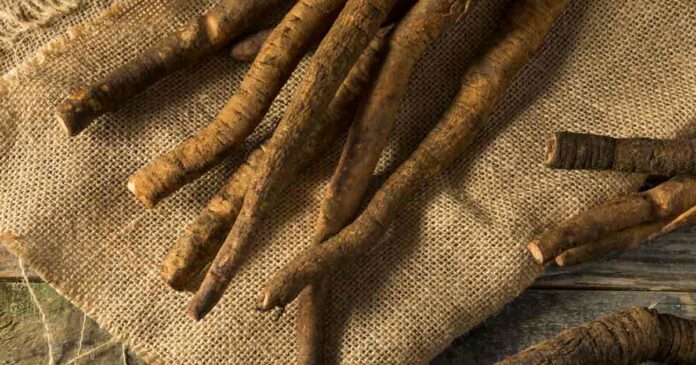Burdock Root: Bitter in Taste, but Sweet on Health Benefits

Story at-a-glance
- Burdock is a flowering plant that has been used by various cultures around the world. Its root holds the most benefits, and is enjoyed in various ways
- Burdock root has been known to provide many health benefits. Read on to find out how you can use burdock root for your well-being
Burdock (Arctium) is a flowering plant that has been a major part of various cultures for over hundreds of years. In Japan, its root is known as “gobo,” and is used in their cuisine.1 The Iroquois tribe of North America, as well as other Native American groups, dried and preserved burdock for food during the winter.2 In China, burdock is traditionally used to help ease inflammation, as well as promote urination and clear toxic heat.3
Fully grown, burdock can reach a height between 1 and 2 meters (3.2 to 6.5 feet), and produces purple flowers that extend away from its bracts that bloom between June and October. The leaves are large, growing up to 50 centimeters (19.6 inches) in total size and have a whitish underside, making burdock an easy plant to identify.4
Burdock is native throughout Europe and Asia, and was introduced in America during the 1600s by English settlers. This was noted by English traveler John Josselyn, who visited New England in 1672 and discovered burdock throughout the areas he went. During this period, the settlers introduced burdock to the Iroquois, and it became a part of their culture as well.5
A fun fact about burdock: It’s the catalyst for the invention of Velcro. In 1941, Swiss engineer George de Mestral was hiking in the Jura Mountains in Switzerland, when he noticed that his pants and his dog’s fur became covered in burdock seeds. He was curious as to how these seeds stuck to his pants, and he discovered that they were covered in small interlocking hooks that can cling to fabric.
He patented this idea, which eventually became Velcro, an invention used in countless products around the world.6
4 Health Benefits of Burdock Root
Burdock contains a mixture of vitamins, minerals and a unique type of fiber to help promote your health. Research has shown that this root can benefit you in several ways, such as:
• Maintaining blood pressure — A single root (156 grams) of burdock contains an impressive 480 milligrams of potassium,7 a mineral known for its benefits for cardiovascular health. Studies have noted that increased potassium intake helped improve blood pressure levels for those who are affected with high blood pressure.
• Promoting gut flora health — In a study published in Anaerobe, researchers discovered that burdock contains inulin, a unique form of fiber.8 Studies have shown that inulin not only helps boost your good bacteria by serving as fuel,9 but also reduces the number of bad bacteria in your gut.10
• Managing inflammation — Burdock root has been found to be effective in managing inflammation, according to a study published in the International Journal of Rheumatic Diseases. Researchers noted that the plant helped lower inflammatory markers among patients with knee osteoarthritis.11
• Lowering the risk of cancer — Research has found that a lignan called arctigenin in burdock has anticancer properties, particularly inducing apoptosis in lung adenocarcinoma cells.12
Culinary Uses of Burdock Root
Burdock root’s reputation mostly lies in cooking. It’s used in a variety of dishes, especially in Japanese cuisine. It is an essential ingredient of kinpira, a dish composed of julienned burdock root, carrot, dried chili peppers and soy sauce.13 Aside from this, you can prepare burdock in various ways, such as:
• Stir-fry — The root can be added to stir-fried vegetables for additional flavor and nutrients.14
• Raw — Burdock root can be eaten raw for a quick and nutritious snack. Be sure to clean it thoroughly first and sprinkle with a little Himalayan salt for flavor.15
• Soup — It can be used as a broth for vegetable soups.16
• Pickled — You can pickle burdock in apple cider vinegar to preserve its shelf life. Adding other herbs and spices to the mixture can give it more nutrients and flavor as well.17
Growing Burdock in Your Home
Growing burdock in your own home is quite easy, since it can grow in various environments with very few problems. With proper care and maintenance, you can yield a high-quality harvest. Remember these tips when planting burdock.
• Preparing the Soil and Seeds — Your soil must be loamy with a neutral pH level and average water.18 Soak the seeds in water overnight to help them germinate quicker.19
• Planting the Seeds — Spread the seeds lightly over your garden bed once the last frost has passed. Afterward, cover them with one-half to three-quarter of an inch of fine garden soil. Tamp down the recently applied top layer, then water lightly.20
• Harvesting and Storing the Roots — The seeds can sprout in just four to seven days. Once they appear and grow a few inches, thin them out 3 inches apart in rows that are 2 inches apart. In roughly eight to 12 weeks, you will be able to harvest the burdock roots.21 Use a shovel or a garden fork when harvesting the roots. You can create a small hole right beside the plant to get the root easily. For the best quality, pick roots once they reach a length of 1 to 2 feet.22
Store the roots by placing them in a shallow dish filled with water, or wrap them in damp paper towels or perforated plastic bags. Harvested roots last only four days, so use them right away before they go bad.23
Burdock Root Recipe: Making Burdock Tea
Burdock can be used in a multitude of dishes, but it is mostly known as an ingredient for tea. Follow this procedure:24
Burdock Root Tea Recipe
Ingredients:
• One burdock root
• 2 liters water (a little over 2 quarts)
Procedure:
1. Using a scouring pad, gently scrape off the remaining dirt and soil from the root under running water. Afterward, cut the root into thin slices. Do not peel the skin, because that’s where most of the nutrients are found.
2. Spread the slices on a bamboo sieve, then cover with a nylon food cover. Place the sieve under clear, sunny weather for one to two days until the slices are dry and pliable. You can use a dehydrator if the weather is not cooperating.
3. Place the dried slices in a pan. Put the pan under low heat, while stirring the slices for 10 minutes until they are golden brown, crispy and emit a fragrant aroma.
4. Let the slices cool for 10 to 15 minutes. To store them, use an airtight container to prevent moisture from entering.
5. Boil the water in a pot, then add 10 grams (a quarter-ounce) of burdock slices. Let the tea simmer for 10 minutes. Strain and enjoy.
6. If you only want to drink one cup, use five to eight slices only. Pour hot water and let the mixture simmer for 5 minutes before drinking.
Note: If you don’t like the taste of burdock tea, you may add raw honey, chrysanthemum, wolf berries or mint leaves for added flavor.
Burdock Can Be Enjoyed as an Essential Oil
Aside from its culinary uses, burdock root can be enjoyed as an essential oil, with benefits mostly associated with the skin and scalp. What makes burdock root oil even better is that you can easily make it in the comfort of your home. To make burdock root oil infusion, all you need are several sticks of dried burdock roots, extra virgin olive oil and a sterile glass jar. Follow this procedure:25
Infused Burdock Oil
Ingredients:
• Dried burdock root
• Extra virgin olive oil
Procedure:
1. Chop the roots into tiny pieces, then pound them lightly with a mallet.
2. Place the roots in the jar then add the olive oil. You can decide how much oil you want to pour.
3. Place the jar in a dark cabinet for six weeks to allow the oil to absorb the roots’ nutrients.
4. Open the jar once a week to release any air bubbles.
5. Once the mixture hits the six-week mark, strain and enjoy.
Benefits of Burdock Oil
As mentioned previously, burdock oil is mostly known for its skin and scalp benefits. It contains vitamin A and various essential fatty acids, which help nourish your scalp and promote healthy hair growth. It can also provide relief from infections and irritations caused by dandruff, as it helps keep sebaceous glands and hair follicles healthy.
Beware the Side Effects of Burdock Root
Before you head off to make your own burdock oil or use the root for cooking, you should be aware of its side effects. You may develop severe allergic reactions upon consumption, as well as contact dermatitis when applied topically.26 To check for any topical irritations, you should do a skin patch test by placing a drop of burdock oil on your arm. Lastly, consult with your doctor before using this oil to avoid any other possible health complications.
Enjoy the Varied Uses of Burdock
Clearly, burdock is no slouch when it comes to how you can apply it. In cooking alone, you can already enjoy the plant in a myriad of ways, and making your own oil essential from burdock increases the usefulness tenfold. Just make sure to consult with your doctor first to check if it’s safe to integrate into your daily diet. Moreover, if you’re buying burdock instead of growing it, obtain it from certified organic growers to protect your health.
Sources and References
- 1 “Wild Vegetarian Cookbook” 2002
- 2 “Field Guide to Produce: How to Identify, Select and Prepare Virtually Every Fruit and Vegetable at the Market” 2004
- 3 “Ancient Wisdom, Modern Kitchen: Recipes From the East for Health, Healing and Long Life” March 9, 2010
- 4 Edible Wild Food, “Burdock”
- 5 EatTheInvaders, January 21, 2013
- 6 Garden Collage, June 3, 2015
- 7 United States Department of Agriculture, 11104, Burdock Root, Raw
- 8 Anaerobe, 2008 Feb;14(1):29-34
- 9 Gastroenterology, 1995 Apr;108(4):975-82
- 10 The American Journal of Clinical Nutrition, 1997 May;65(5):1397-402
- 11 International Journal of Rheumatic Diseases, 2016 Mar;19(3):255-261
- 12 Phytomedicine, 2013 Dec 15;21(1):39-46
- 13 Specialty Produce, “Burdock Root (Gobo)”
- 14, 15, 21, 22 Eatweeds, “Edible Burdock Root Recipe”
- 16 Happy Homemaker88, “Nutritious Burdock Root Herbal Soup for Detoxification” November 15, 2007
- 17 The Teacup Chronicles, “Japanese Style Pickled Burdock” May 10, 2012
- 18 Gardening Know How, “Burdock Plant Care — How to Grow Burdock in the Garden”
- 19 Organic Gardener, February 12, 2010
- 20 The Gardener’s Network, “How to Grow Burdock”
- 23 Fruits & Veggies More Matters, “Burdock Root: Nutrition, Selection, Storage”
- 24 Ma Recipes, “Burdock Tea”
- 25 Pioneer Thinking, “How to Reverse Hair Thinning With Burdock Root Oil”
- 26 “American Herbal Products Association’s Botanical Safety Handbook, Second Edition” March 15, 2013

